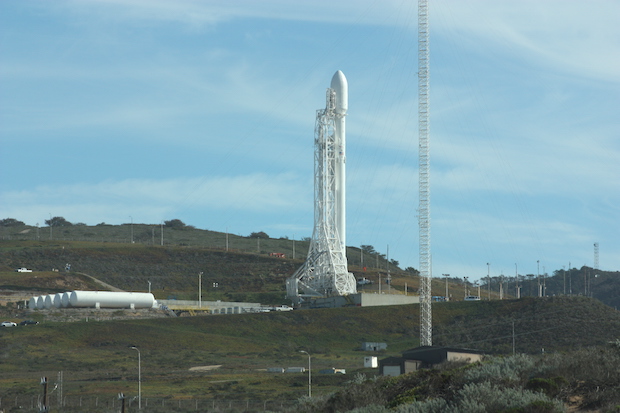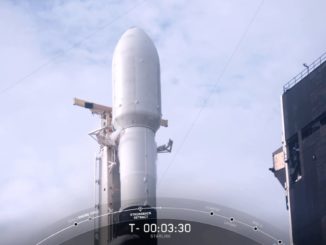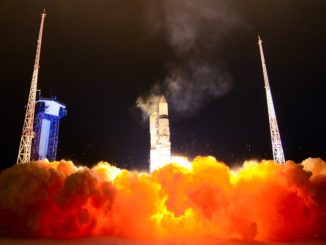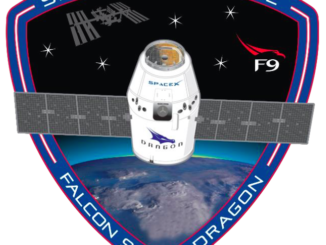
SpaceX’s launch team fueled up a Falcon 9 rocket on a California launch pad Thursday, fired the booster’s nine Merlin engines, and passed a key preflight test for the first time since a Falcon 9 exploded during a similar practice countdown in September.
The customary launch rehearsal, called a static fire test, helps clear the way for the rocket’s blastoff next week with 10 next-generation Iridium voice and data relay satellites.
The launch from Vandenberg Air Force Base on California’s Central Coast will be SpaceX’s first mission since a Sept. 1 rocket explosion on a launch pad at Cape Canaveral, when a Falcon 9 blew apart during fueling for a static fire test a few days before a launch with the Amos 6 communications satellite owned by Spacecom Ltd. of Israel.
The mishap destroyed the rocket and the Amos 6 spacecraft, and left SpaceX’s Complex 40 launch pad in Florida with major damage.
SpaceX has changed the practice of conducting the static fire tests with satellites on-board in the wake of the Sept. 1 explosion, and Iridium’s 10 communications craft will be mated to the Falcon 9 this weekend ahead of launch next week.
Ground crews planned to return the two-stage rocket to its assembly hangar, where the Iridium payloads are already encapsulated inside the Falcon 9’s clamshell-like nose fairing.
The 229-foot (70-meter) rocket will be returned to the Space Launch Complex 4-East launch pad at Vandenberg ahead of launch next week.
SpaceX announced the completion of its investigation into the Sept. 1 explosion Monday, concluding that one of three composite overwrapped pressure vessels, or COPVs, inside the second stage’s liquid oxygen tank suddenly ruptured during fueling of the Falcon 9 rocket.
“Specifically, the investigation team concluded the failure was likely due to the accumulation of oxygen between the COPV liner and overwrap in a void or a buckle in the liner, leading to ignition and the subsequent failure of the COPV,” SpaceX said in a statement posted to the company’s website.
The Hawthorne, California-based company said in the announcement it planned the Falcon 9 rocket’s return-to-flight mission Sunday, Jan. 8. But preparations for the static fire took longer than expected, and sources said the launch has been pushed back to no earlier than Monday.
The Federal Aviation Administration, which has regulatory oversight for commercial space launch activity, must receive SpaceX’s inquiry report and sign off on the results, then issue a launch license for the Iridium Next mission, the first of at least seven SpaceX launches planned for the mobile telecom provider.
As of Thursday, the FAA had not approved the license for the Iridium Next launch.
According to SpaceX, the Falcon 9 second stage’s design has the COPVs, which are used to store cold helium to pressurize the rocket’s propellant system, inside the liquid oxygen tank.
Both stages of the Falcon 9 consume a mixture of kerosene and liquid oxygen.
The latest version of SpaceX’s Falcon 9 rocket burns super-chilled propellants, with liquid oxygen stored at minus 340 degrees Fahrenheit (minus 206 degrees Celsius) and RP-1 kerosene at around 20 degrees Fahrenheit (minus 6 degrees Celsius). The liquid oxygen and RP-1 propellants are normally kept at around minus 298 degrees Fahrenheit (minus 183 degrees Celsius) and 70 degrees Fahrenheit (21 degrees Celsius).
The colder temperatures make the propellants more dense, allowing the rocket to hold more fuel and its engines to generate more thrust.
Each high-pressure helium tank is made with an aluminum inner liner overwrapped with carbon, and experts sifting through debris scattered by the rocket explosion found buckles in the COPVs recovered around the launch pad.
“Although buckles were not shown to burst a COPV on their own, investigators concluded that super chilled LOX can pool in these buckles under the overwrap,” SpaceX said. “When pressurized, oxygen pooled in this buckle can become trapped; in turn, breaking fibers or friction can ignite the oxygen in the overwrap, causing the COPV to fail.”
SpaceX said investigators determined that the helium was cold enough to create solid oxygen, a condition that “exacerbates” the chance of oxygen becoming trapped and the likelihood of friction ignition.
Engineers were unable to come to a definitive cause for the explosion, which occurred so fast that only 93 milliseconds elapsed from the first sign of “anomalous data” until the loss of the second stage, SpaceX said.
“The investigation team identified several credible causes for the COPV failure, all of which involve accumulation of super chilled LOX or SOX (solid oxygen) in buckles under the overwrap,” SpaceX said in the Jan. 2 statement. “The corrective actions address all credible causes and focus on changes which avoid the conditions that led to these credible causes.
“In the short term, this entails changing the COPV configuration to allow warmer temperature helium to be loaded, as well as returning helium loading operations to a prior flight proven configuration based on operations used in over 700 successful COPV loads,” SpaceX said. “In the long term, SpaceX will implement design changes to the COPVs to prevent buckles altogether, which will allow for faster loading operations.”
Email the author.
Follow Stephen Clark on Twitter: @StephenClark1.



